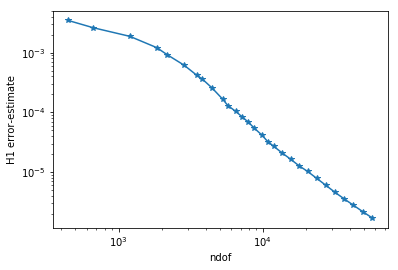This page was generated from jupyter-files/unit-1.6-adaptivity/adaptivity.ipynb.
1.6 Error estimation & adaptive refinement¶
In this tutorial, we apply a Zienkiewicz-Zhu type error estimator and run an adaptive loop with these steps:
[1]:
import netgen.gui
%gui tk
from ngsolve import *
from netgen.geom2d import SplineGeometry
import matplotlib.pyplot as plt
Geometry¶
The following geometry represents a heating chip embedded in another material that conducts away the heat.
[2]:
# point numbers 0, 1, ... 11
# sub-domain numbers (1), (2), (3)
#
#
# 7-------------6
# | |
# | (2) |
# | |
# 3------4-------------5------2
# | |
# | 11 |
# | / \ |
# | 10 (3) 9 |
# | \ / (1) |
# | 8 |
# | |
# 0---------------------------1
#
def MakeGeometry():
geometry = SplineGeometry()
# point coordinates ...
pnts = [ (0,0), (1,0), (1,0.6), (0,0.6), \
(0.2,0.6), (0.8,0.6), (0.8,0.8), (0.2,0.8), \
(0.5,0.15), (0.65,0.3), (0.5,0.45), (0.35,0.3) ]
pnums = [geometry.AppendPoint(*p) for p in pnts]
# start-point, end-point, boundary-condition, domain on left side, domain on right side:
lines = [ (0,1,1,1,0), (1,2,2,1,0), (2,5,2,1,0), (5,4,2,1,2), (4,3,2,1,0), (3,0,2,1,0), \
(5,6,2,2,0), (6,7,2,2,0), (7,4,2,2,0), \
(8,9,2,3,1), (9,10,2,3,1), (10,11,2,3,1), (11,8,2,3,1) ]
for p1,p2,bc,left,right in lines:
geometry.Append(["line", pnums[p1], pnums[p2]], bc=bc, leftdomain=left, rightdomain=right)
geometry.SetMaterial(1,"base")
geometry.SetMaterial(2,"chip")
geometry.SetMaterial(3,"top")
return geometry
mesh = Mesh(MakeGeometry().GenerateMesh(maxh=0.2))
Spaces & forms¶
The problem is to find \(u\) in \(H_{0,D}^1\) satisfying
for all \(v\) in \(H_{0,D}^1\). We expect the solution to have singularities due to the nonconvex re-enrant angles and discontinuities in \(\lambda\).
[3]:
fes = H1(mesh, order=3, dirichlet=[1])
u, v = fes.TnT()
# one heat conductivity coefficient per sub-domain
lam = CoefficientFunction([1, 1000, 10])
a = BilinearForm(fes)
a += SymbolicBFI(lam*grad(u)*grad(v))
# heat-source in inner subdomain
f = LinearForm(fes)
f += SymbolicLFI(CoefficientFunction([0, 0, 1])*v)
c = Preconditioner(a, type="multigrid", inverse="sparsecholesky")
gfu = GridFunction(fes)
Draw (gfu)
Note that the linear system is not yet assembled above.
Solve¶
Since we must solve multiple times, we define a function to solve the boundary value problem, where assembly, update, and solve occurs.
[4]:
def SolveBVP():
fes.Update()
gfu.Update()
a.Assemble()
f.Assemble()
inv = CGSolver(a.mat, c.mat)
gfu.vec.data = inv * f.vec
Redraw (blocking=True)
[5]:
SolveBVP()
Estimate¶
We implement a gradient-recovery-type error estimator. For this, we need an H(div) space for flux recovery. We must compute the flux of the computed solution and interpolate it into this H(div) space.
[6]:
space_flux = HDiv(mesh, order=2)
gf_flux = GridFunction(space_flux, "flux")
flux = lam * grad(gfu)
gf_flux.Set(flux)
[7]:
err = 1/lam*(flux-gf_flux)*(flux-gf_flux)
Draw(err, mesh, 'error_representation')
Element-wise error estimator: On each element \(T\), set
where \(u_h\) is the computed solution gfu and \(I_h\) is the interpolation performed by Set in NGSolve.
[8]:
eta2 = Integrate(err, mesh, VOL, element_wise=True)
print(eta2)
2.36461e-10
1.18698e-08
5.03613e-06
6.34682e-11
4.33101e-11
1.7484e-11
1.58609e-10
6.33751e-09
1.19293e-10
1.35243e-07
1.98437e-07
2.00923e-07
1.16473e-08
1.251e-07
2.2953e-07
5.73909e-09
3.385e-11
3.31297e-10
3.32684e-10
3.89806e-07
2.26934e-07
2.60348e-07
3.3506e-07
8.52564e-10
2.40196e-06
3.57631e-06
2.45321e-08
1.29118e-10
8.8645e-08
3.87456e-08
1.6248e-07
7.55763e-08
3.12331e-06
3.79783e-10
1.90566e-07
1.04137e-09
6.8768e-07
7.2601e-07
3.8487e-07
1.43514e-10
1.35152e-10
6.55815e-07
1.82416e-07
7.13649e-08
9.56596e-09
6.74125e-09
3.28339e-10
2.90424e-09
5.48405e-08
1.15509e-08
1.45004e-08
2.01172e-08
1.37504e-08
1.13422e-07
3.51327e-08
1.27836e-10
5.86447e-12
4.22009e-12
3.1807e-10
5.72781e-13
1.2421e-11
5.4183e-12
2.41244e-10
6.65466e-07
8.8388e-08
The above values, one per element, lead us to identify elements which might have large error.
Mark¶
We mark elements with large error estimator for refinement.
[9]:
maxerr = max(eta2)
print ("maxerr = ", maxerr)
for el in mesh.Elements():
mesh.SetRefinementFlag(el, eta2[el.nr] > 0.25*maxerr)
Draw(gfu)
maxerr = 5.036125830814317e-06
Automate the above steps¶
[11]:
l = [] # l = list of estimated total error
def CalcError():
# compute the flux:
space_flux.Update()
gf_flux.Update()
flux = lam * grad(gfu)
gf_flux.Set(flux)
# compute estimator:
err = 1/lam*(flux-gf_flux)*(flux-gf_flux)
eta2 = Integrate(err, mesh, VOL, element_wise=True)
maxerr = max(eta2)
l.append ((fes.ndof, sqrt(sum(eta2))))
print("ndof =", fes.ndof, " maxerr =", maxerr)
# mark for refinement:
for el in mesh.Elements():
mesh.SetRefinementFlag(el, eta2[el.nr] > 0.25*maxerr)
[12]:
CalcError()
mesh.Refine()
ndof = 445 maxerr = 2.511445609726963e-06
Run the adaptive loop¶
[13]:
while fes.ndof < 50000:
SolveBVP()
CalcError()
mesh.Refine()
ndof = 664 maxerr = 9.300425565031251e-07
ndof = 1192 maxerr = 3.414646836906428e-07
ndof = 1834 maxerr = 2.1472585059819264e-07
ndof = 2167 maxerr = 9.835056165137945e-08
ndof = 2839 maxerr = 4.917040165457557e-08
ndof = 3466 maxerr = 2.458740959858597e-08
ndof = 3805 maxerr = 1.2294699792242802e-08
ndof = 4450 maxerr = 6.145986051434467e-09
ndof = 5257 maxerr = 3.071914052546866e-09
ndof = 5713 maxerr = 1.5353408223467698e-09
ndof = 6475 maxerr = 7.673155137357938e-10
ndof = 7165 maxerr = 3.8347357373724957e-10
ndof = 7900 maxerr = 1.9164536414781034e-10
ndof = 8719 maxerr = 9.577670728615699e-11
ndof = 9853 maxerr = 4.7867485757047704e-11
ndof = 10810 maxerr = 2.392324427586057e-11
ndof = 11884 maxerr = 1.1956352408132547e-11
ndof = 13513 maxerr = 5.975487707207399e-12
ndof = 15553 maxerr = 2.986452644572587e-12
ndof = 17776 maxerr = 1.4925627796160417e-12
ndof = 20404 maxerr = 7.459783254409289e-13
ndof = 23653 maxerr = 3.7281573519588415e-13
ndof = 27394 maxerr = 1.863284713063423e-13
ndof = 31690 maxerr = 9.312791086715527e-14
ndof = 36811 maxerr = 4.6543377383552036e-14
ndof = 42022 maxerr = 2.3263412632625325e-14
ndof = 49306 maxerr = 1.1626515614277681e-14
ndof = 57589 maxerr = 5.81163901405017e-15
Plot history of adaptive convergence¶
[14]:
plt.yscale('log')
plt.xscale('log')
plt.xlabel("ndof")
plt.ylabel("H1 error-estimate")
ndof,err = zip(*l)
plt.plot(ndof,err, "-*")
plt.ion()
plt.show()
